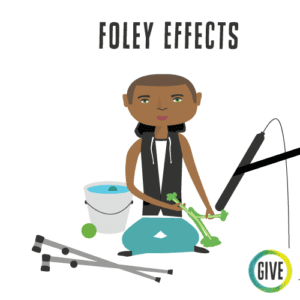Making Foley Sounds
کی طرف سے تعاون کیا لورا بورگوارٹ
![]()
![]()
Description
This activity helps students discover how the sounds used in movies and animations are created behind the scenes, by practicing making sounds with various objects and matching them with the actors’ actions and moods. Students will have a chance to become actors, Foley artists, and audience members, working in collaboration to build a positive community in the classroom.
ہدایات
- Introduce the class to Foley—Foley effects are the sounds that are added to a movie or a play. They help increase the sound quality and help tell a specific story.

- Have students explore different Foley objects—what sounds do they make?
- “Today we are going to make the sounds of different characters moving across the stage. Some characters might be realistic and their footsteps might sound like shoes walking on the floor; some characters might be silly and their footsteps sound a little wacky (e.g., the SpongeBob SquarePants walking noise); and some characters might slither or crawl across the space.”
- Have one actor (maybe a Classroom Professional) move across the stage/space/screen in a specific way. “How did the actor move? Were their movements small/big? Light/heavy? Realistic/silly? Does anyone have a sound effect that matches that character?”
- The actor will cross the space again, this time with the Foley artist matching their movements with sound. “Make sure to pay attention—the sound should happen at the exact moment their foot or other body part hits the floor.”
- Try working backward! Have one of your Foley artists play a sound and have that sound inspire the actor to create a way of moving that matches the Foley.
- عکس:
- “Did you like being an actor or a Foley artist better? Why?”
- “What were the important skills we needed in each of the roles?”
- Extensions: You could have a puppet move across the space and match their footsteps, or have the actor “walk” with different parts of their body (e.g., fingers, elbows, etc.).
Transition Into Activity
اپنے ہاتھ میں چھپی ہوئی اسکوئیکر یا دیگر فولے آبجیکٹ کے ساتھ اسپیس میں داخل ہوں اور اپنے قدموں کو اسکوئیکر کے ساتھ جوڑیں۔ بہت الجھن کا مظاہرہ کریں اور کلاس سے پوچھیں کہ کیا وہ یہ شور سنتے ہیں۔ اپنے فولے آبجیکٹ کو دریافت کریں۔
Transition Out of Activity
“What Foley sound could we use for someone falling asleep/snoring? Let’s all try. Relax. Sleep. Okay, wake up! (Bringggggg!) It’s time to get back to class.”
کلاس روم کا انتظام
Audience/playing space.
سپورٹ / انکولی مواد / ٹولز
- For those with sound sensitivities, you can have headphones available to wear during the game or find a seat for them that is further from the Foley artists.
- Have lots of different kinds of Foley that are manipulated in different ways—squeeze, hit, scrunch, slap. Have options that require both fine motor and gross motor skills.
- اگر آپ واقعی پسند ہیں اور آپ کے پاس مائیکروفون ہے تو، مائیکروفون کو Foley فنکاروں کے پاس رکھیں تاکہ وہ صوتی اثرات بنانے کے لیے اشیاء کی وسیع رینج کا استعمال کر سکیں۔
- Visual Vocabulary Cards (downloadable).
- Video examples to learn about Foley sounds:
Possible Roles for Classroom Professionals
- Model 100% participation—encourage a Classroom Professional to volunteer to be the first actor and invite them to be as silly as they can. Their willingness to take a risk will encourage the students to do so as well.
- Side-coach Foley artists: “Got your object ready? Okay, they are taking the first step—squeeze!”
Adjustments for Remote Instruction
![]()
یہ آن لائن کلاسز کے لیے ایک اچھا گیم ہے جہاں کچھ طلبا اپنا کیمرہ آن کرنا چاہتے ہیں (وہ اداکار ہو سکتے ہیں!) اور کچھ اپنا کیمرہ بند رکھنا چاہتے ہیں (وہ فولی آرٹسٹ ہو سکتے ہیں!)۔ آواز بنانے کے لیے طلباء کے گھروں میں موجود چیزوں کی کچھ مثالوں کے ساتھ تیار کلاس میں آئیں۔ اداکار کو یہ یقینی بنانے کی ضرورت ہوگی کہ ان کے جسم کا زیادہ سے زیادہ حصہ فریم میں ہے، خاص طور پر اگر وہ اپنی جگہ پر چل رہے ہوں۔ یقینی بنائیں کہ سامعین کے تمام اراکین خاموش ہیں تاکہ فولی آرٹسٹ کو سنا جا سکے۔
